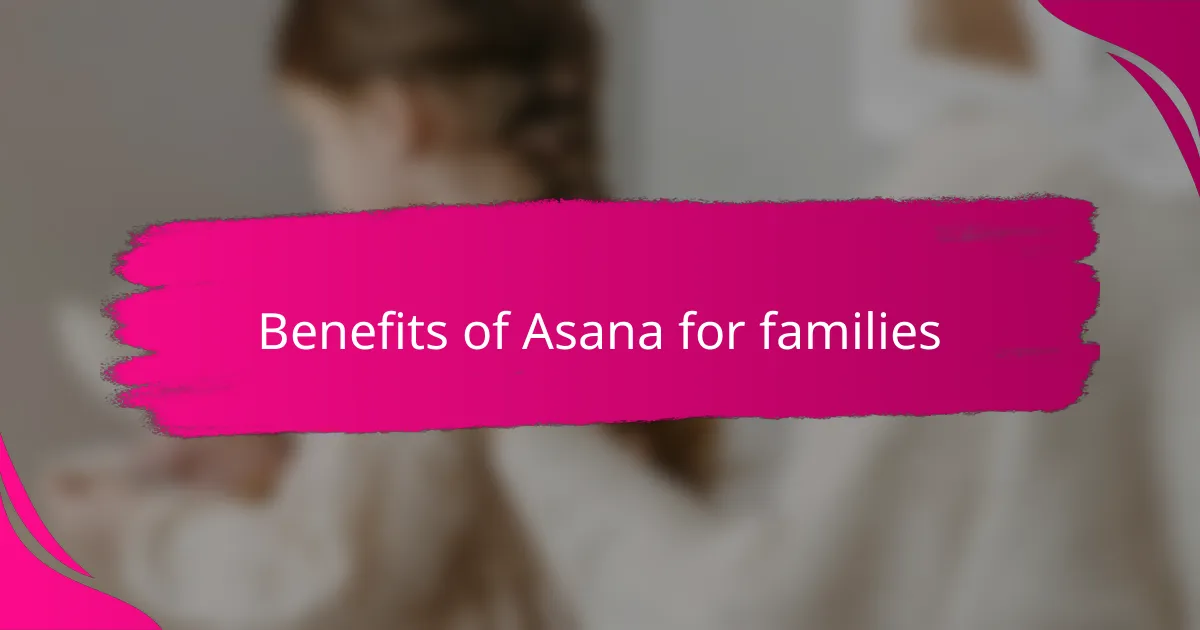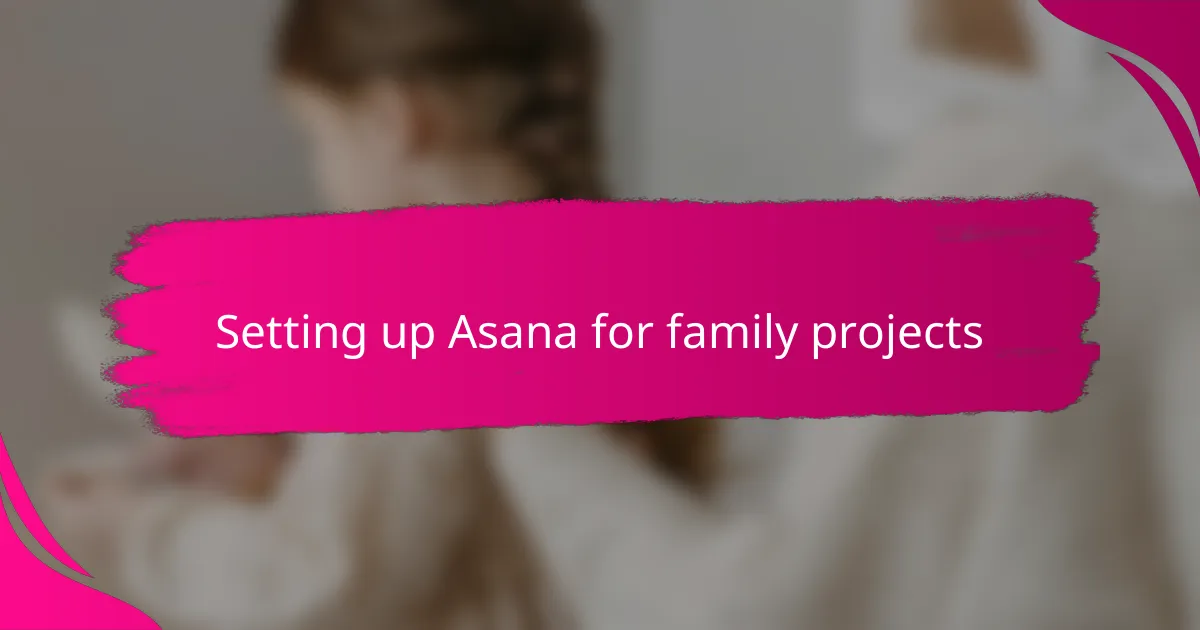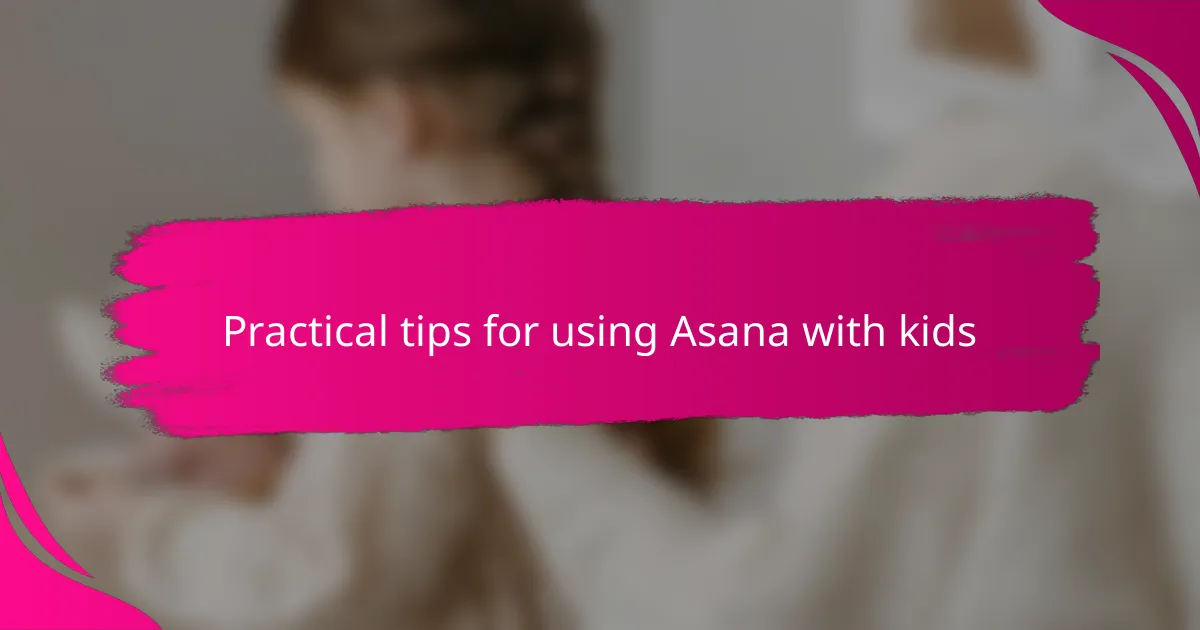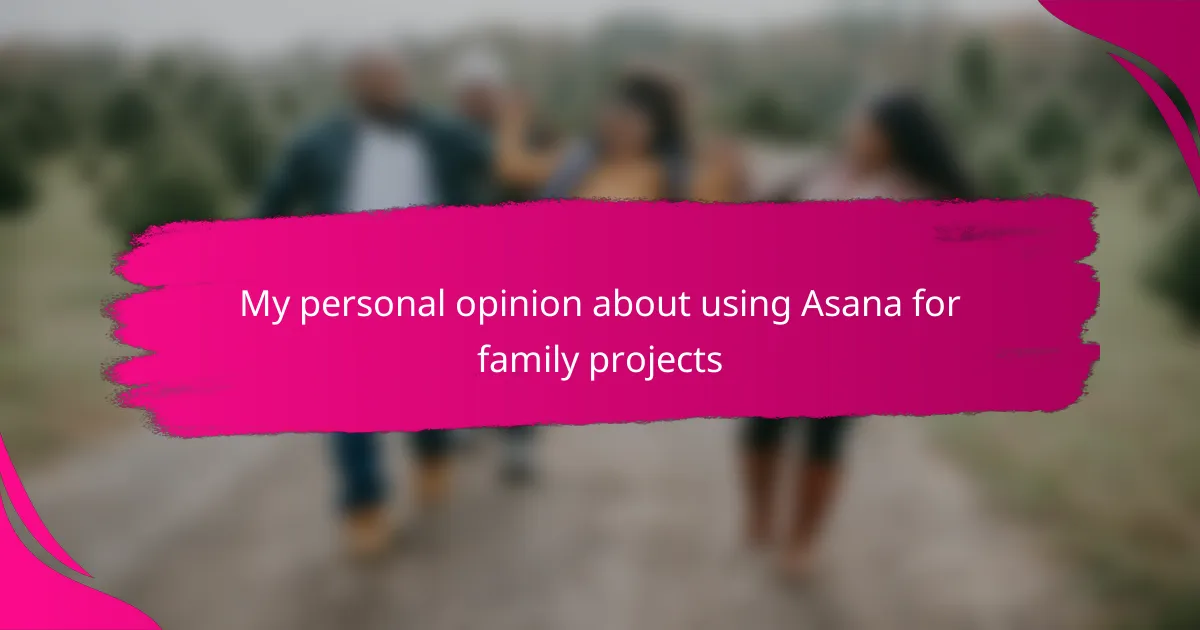Key takeaways
- Asana helps families organize tasks and projects in a centralized way, reducing confusion and enhancing communication.
- Customizing notifications and using simple task descriptions keeps family members engaged and aware of their responsibilities.
- Regular family check-ins to review tasks foster collaboration, celebrate achievements, and build confidence among children.
- Breaking tasks into smaller steps prevents overwhelm and makes planning more manageable for everyone.

What is Asana and its uses
Asana is a digital tool designed to help organize tasks and projects in one place. When I first tried it, I was surprised at how easily I could create to-do lists and assign responsibilities with just a few clicks. Have you ever felt overwhelmed trying to keep track of family errands or plans? That’s exactly where Asana comes in handy.
Its uses go beyond just work-related projects; it can be a central hub for managing everything from grocery shopping to planning a birthday party. I found that sharing a project with my spouse made coordinating our schedules less stressful and more transparent. Isn’t it amazing how a simple app can turn chaos into clarity?
What I appreciate most about Asana is its flexibility—it lets you customize how you view your tasks, whether through lists, boards, or calendars. This means you can adapt it to whatever style helps your family stay on track. Have you ever wished for a single place where everyone’s input is visible? For me, Asana has become that reliable spot.

Benefits of Asana for families
One of the biggest benefits I noticed is how Asana brings everyone together in one virtual space. When my kids needed reminders for their chores and school projects, having everything clearly laid out reduced the usual nagging and confusion. Isn’t it great when a tool helps your family communicate better without the constant back-and-forth?
Another thing I love is how Asana helps prioritize tasks so nothing important slips through the cracks. For example, during holiday planning, I could easily see what needed to be done next, and everyone knew their part. This kind of organization takes a huge load off my mind and keeps the whole family aligned.
What really surprised me is how Asana also makes celebrating small victories a joy. Checking off completed tasks together feels rewarding and motivates us to keep going. Have you ever experienced that satisfying feeling of progress? With Asana, it turns family teamwork into something fun and fulfilling.

Setting up Asana for family projects
When setting up Asana for family projects, I found it helpful to start with simple categories like chores, appointments, and special events. Breaking things down this way made it easier for everyone—even the kids—to know where to look. Have you ever tried organizing a family schedule only to have everyone get confused? This method really cuts through that chaos.
I also learned that inviting each family member to join the project early on created a sense of ownership. It’s one thing for me to assign tasks, but when my daughter added her own homework deadlines, the tool became truly collaborative. Don’t you think everyone feels more motivated when they have a say in the plan?
Finally, customizing notifications made a huge difference. Rather than overwhelming my inbox, I set Asana to alert us only for urgent or upcoming tasks. That way, reminders popped up just in time without becoming a distraction. How often have you wished for timely nudges that don’t add to screen fatigue? This balance has been a game-changer for our family workflow.

Practical tips for using Asana with kids
One trick I found useful was to keep task descriptions simple and clear when adding kids to Asana. If the instructions are too long or complicated, I noticed my younger ones would just ignore the tasks. Have you ever seen your child’s eyes glaze over at a long to-do list? That’s why I stick to just a few words and sometimes add emojis—just enough to make it fun and easy to understand.
Another tip is to set up recurring tasks for daily or weekly chores. My kids love ticking off boxes on their own, and seeing their progress motivates them without me having to remind them constantly. Isn’t it amazing how turning routine into a game can change the whole dynamic? Plus, it frees me up from repeating the same instructions over and over.
Finally, I recommend sitting down weekly as a family to review the tasks together on Asana. This little check-in turned out to be a great opportunity to celebrate wins and adjust plans. When my son gets to share what he accomplished or suggest new tasks, it makes him feel proud and responsible. Don’t you think involving kids like this helps build their confidence while keeping everyone on the same page?

Common challenges and solutions
Sometimes, getting everyone in the family to consistently use Asana can feel like herding cats. I remember when I first invited my teenagers to join the app; it took a bit of coaxing to convince them to check their tasks regularly. Have you ever struggled to get your kids to stick with a new routine? What helped me was setting up simple reminders and making sure the tasks felt relevant to their daily lives.
Another challenge I faced was tackling the occasional tech hiccup. Not everyone in the family is tech-savvy, and there were moments when a task got lost or a notification was missed. I found that having a quick family “Asana refresher” chat helped keep everyone on track. Do you think a little patience and open communication can smooth over these bumps? From my experience, it definitely pays off.
Lastly, it’s easy to overload the board with too many tasks, which can overwhelm everyone. When I saw my family feeling stressed by a long list, I learned to prioritize and break projects into smaller, manageable steps. Isn’t it better when the plan feels doable instead of daunting? This small change made our whole process feel lighter and more encouraging.

My personal experience with Asana
When I first started using Asana for family projects, I didn’t expect it to make such a big difference in how we communicate. I remember one hectic week when everyone’s schedules clashed, and just by organizing tasks clearly on Asana, the chaos smoothed out. Have you ever felt like your family’s running in different directions? That’s exactly how Asana helped us find common ground.
What surprised me most was how even the kids took ownership once they saw their tasks listed. My youngest started reminding me about her homework deadlines, which felt like a small personal victory. Isn’t it amazing when a tool not only organizes but also empowers everyone to contribute?
Of course, it wasn’t perfect from day one. At times, I had to gently nudge family members to check the app, especially my teenagers. But seeing the little wins accumulate—like a chore finally done without being asked—made me realize that keeping this virtual plan alive was worth every reminder. Have you noticed how sometimes a nudge is all it takes to change a habit? For us, Asana became that gentle push towards better teamwork.
